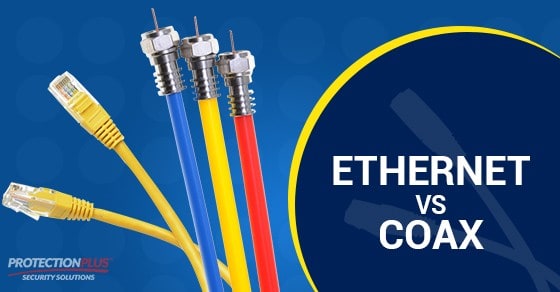When asking what the difference is between Ethernet and coax, there is no one answer as this question has some layers to it. Ethernet is a method of network communication that can be carried by many different cables, including coaxial cables.
In modern slang, though, “Ethernet cables” refer to twisted pair cables, usually used to network devices together, while coaxial cables refer to high-frequency shielded cables, and are used to connect rooms or buildings.
What is Ethernet?
Commercially introduced in 1980, Ethernet is a networking technology that divides data into packets called “frames.” Each frame contains actual data, metadata about the sender and receiver, and backup data to check for errors. A device that receives a data checks to see if it is from an appropriate sender, verifies that nothing has been corrupted, and then adds it to previously decoded frames to produce a constant stream. Ethernet is normally used in local area networks (LANs) and metropolitan area networks (MANs). LANs are networks that link devices within a building or group of neighbouring buildings while MANs is a network that is designed to link an entire city.
Ethernet continues to be the technology of choice when it comes to linking local area networks because of its compatibility and reliability with networking protocols. This has a lot of advantages over other networking methods. Even if the cable is not perfectly shielded, the ability to verify frames prevents any one bad packet of data from corrupting the whole stream. From a security point of view, it is difficult to tap into data that’s marked for a specific receiver.
Ethernet has been previously used with coaxial cables but has become so advanced that heavily shielded cables are no longer needed. Instead, it usually uses twisted pair cables.
What are Ethernet cables used for?
These cables are used on wired networks to connect devices like PCs, routers and switches to LANs. There are different types of Ethernet cables, the most commonly used being the Category 5 (CAT5) and the Category 6 (CAT6). Generally, Ethernet cables are made to connect only one device but you can also use a crossover cable which is a special Ethernet cable designed to connect two computers to each other.
Ethernet cables are made in two forms. First, the solid form which offers better performance and improved protection from electrical interference. This type of Ethernet cable is more commonly found in business networks where wiring is inside office walls or under lab floors tethered to fixed locations. The second form of Ethernet cable is the stranded type. Stranded cables are less likely to incur damage such as cracks and breaks. They are typically used by travellers or in a home networking situation.
Twisted pair cables are, as you guessed, a pair twisted together, like a DNA double helix. This twist creates a situation where the fields produced by the cables largely cancel each other out. For Internet use, businesses use Category 6 cables that can reach for about 175 feet before the interference becomes too severe. 175 feet is more than enough for most small businesses, so people opt to just use twisted pair cables to build a network.
With a large office building, coaxial cables are more useful.
Coaxial Cables
Coaxial Cables use one cable as a wraparound shield that protects the other. Coax cables are highly shielded and can carry a signal for huge distances. Large office buildings use these cables to link up a large floor, or multiple-floor, networks.
Coaxial cables contain an inner conductor that is encased by a tubular insulating layer, fenced by a tubular conducting shield. The name “coax” refers to the fact that these two layers, the outer sheath and the conductor beneath it, share a geometric axis. Coaxial cables have actually been in existence since the 1880s when mathematician and engineer Oliver Heaviside patented their design.
What’s the difference between coax and other shielded cables?
The dimensions of coax cables are controlled unlike with other shielded cables. By controlling the cable’s dimensions, you get precise and constant conductor spacing. This is very important to create effective functionality when carrying lower-frequency transmission signals.
What are coaxial cables used for?
Generally, coax cables are used for audio and visual functions. In modern homes, you will find at least one coax outlet in each room. Cable companies usually use coaxial cables to connect a signal directly from the wall outlet to your television or cable box. Back in the day, coax cables were used to attach antennas to TVs or digital converter boxes. They were also used to connect VCRs to a TV, but who has one of those anymore?
Coaxial cables are pricier, unfortunately, running you between 75 cents and per foot, compared to the 15–50 cents for a twisted pair cable. This adds up in a large operation but is often unavoidable.
- Access Control
- Alarm monitoring
- Alarm Systems
- cannabis
- cannabis retailer
- CCTV Cameras
- Childproof Doors
- Commercial Security
- Construction Security
- Cybersecurity
- Digital Safety
- Door Bell
- Ethernet
- fire
- flood
- garage
- General Category
- Halloween
- holiday
- home
- home automation
- Home Safety
- Home Security
- Home Security System
- In the News
- intercom
- internet
- life insurance
- Locksmith
- Move Ahead
- moving
- MUL-T-LOCK
- natural disasters
- New Years
- Office Security
- Personal Safety
- Pet Protection
- real estate
- Safes
- Safes
- safety
- school
- Security Cameras
- Security Film
- Security Industry News
- Security Systems
- Security Tips
- security window film
- Senior Safety
- shoplifting
- Small Business
- Small Business security
- social media
- social network
- Sports Safety
- summer
- vacation
- Video Alarm Monitoring
- web
- web surfing
- Webdesign
- Window Film
- winter
- Workplace safety








